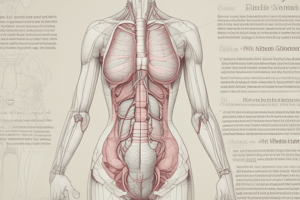Podcast
Questions and Answers
What is one common surgical treatment option for treating a prolapsed pelvic organ?
What is one common surgical treatment option for treating a prolapsed pelvic organ?
- Coronary artery bypass
- Hysterectomy (correct)
- Laparoscopic appendectomy
- Cholecystectomy
Which of the following is NOT a pelvic floor muscle training method mentioned for prolapse treatment?
Which of the following is NOT a pelvic floor muscle training method mentioned for prolapse treatment?
- Kegel exercises
- Biofeedback
- Cognitive behavioral therapy (correct)
- Regular exercise
Which nutritional strategy can help manage constipation in individuals with prolapse?
Which nutritional strategy can help manage constipation in individuals with prolapse?
- Reducing fiber intake
- Increasing water intake (correct)
- Eating more processed foods
- Limiting physical activity
Which behavior modification is recommended to avoid worsening prolapse symptoms?
Which behavior modification is recommended to avoid worsening prolapse symptoms?
What is a pessary used for in the context of pelvic organ prolapse?
What is a pessary used for in the context of pelvic organ prolapse?
Which of the following is a physiological change that occurs during pregnancy?
Which of the following is a physiological change that occurs during pregnancy?
What adaptation in urinary changes is likely to occur during pregnancy?
What adaptation in urinary changes is likely to occur during pregnancy?
What is a common symptom associated with pelvic organ prolapse?
What is a common symptom associated with pelvic organ prolapse?
What is the primary function of the coccygeus and levator ani muscles?
What is the primary function of the coccygeus and levator ani muscles?
Which type of muscle fibers are predominantly found in the pelvic floor muscles?
Which type of muscle fibers are predominantly found in the pelvic floor muscles?
How does the autonomic nervous system influence the tone of pelvic floor muscles?
How does the autonomic nervous system influence the tone of pelvic floor muscles?
What anatomical structures interrupt the urogenital diaphragm in females?
What anatomical structures interrupt the urogenital diaphragm in females?
What is a key characteristic of the transverse perineal muscles?
What is a key characteristic of the transverse perineal muscles?
Which of the following muscles plays a significant role in hip external rotation and pelvic floor activation?
Which of the following muscles plays a significant role in hip external rotation and pelvic floor activation?
What additional function is provided by the pelvic floor besides supporting organs?
What additional function is provided by the pelvic floor besides supporting organs?
What role does the resting tone of pelvic floor muscles play in bodily functions?
What role does the resting tone of pelvic floor muscles play in bodily functions?
Which muscle group is associated with significant hip and back pain when there is pelvic floor dysfunction?
Which muscle group is associated with significant hip and back pain when there is pelvic floor dysfunction?
Activation of pelvic floor muscles during sexual activity is primarily beneficial for which purpose?
Activation of pelvic floor muscles during sexual activity is primarily beneficial for which purpose?
What is a common symptom of pelvic organ prolapse?
What is a common symptom of pelvic organ prolapse?
What percentage of women with children experience pelvic organ prolapse?
What percentage of women with children experience pelvic organ prolapse?
What is a 2nd degree uterine prolapse?
What is a 2nd degree uterine prolapse?
Which option best describes a cystocele?
Which option best describes a cystocele?
Which symptom is likely to worsen with prolonged standing or straining?
Which symptom is likely to worsen with prolonged standing or straining?
What is the most common type of pelvic floor disorder?
What is the most common type of pelvic floor disorder?
What could be associated with pelvic floor muscle dysfunction?
What could be associated with pelvic floor muscle dysfunction?
Which type of pelvic organ prolapse involves the rectum?
Which type of pelvic organ prolapse involves the rectum?
Flashcards are hidden until you start studying
Study Notes
Assessment of Core Positions
- Observation includes seated and standing drawing in with leg and arm movement, incorporating weighted/resisted training.
- Leg lift exercises are performed from a supine position near a wall, with gradually increasing distance from the wall and potential for resistance.
Pelvic Floor Disorders
- Conditions arising from weakened pelvic floor muscles and ligaments, impairing support for pelvic organs.
- Common disorders: prolapse, urinary incontinence, fecal incontinence, often linked to pelvic floor muscle dysfunction.
Prolapse
- Refers to descent or decreased support of internal pelvic organs; affects approximately half of women post-childbirth.
- Association with other pelvic issues like stress incontinence and overactive bladder.
Types of Prolapse
- Cystocele: bladder protrudes into the anterior vaginal wall.
- Rectocele: rectum bulges into the posterior vaginal wall.
- Uterine prolapse: uterus descends into the vagina.
- Severity ranges from first-degree (minimal descent) to third-degree (protrusion through vaginal opening).
Signs and Symptoms of Prolapse
- Presence of a lump in the vaginal area.
- Pain or pressure sensations, especially in prolonged standing or during strain.
- Painful intercourse, back pain, abdominal cramping.
- Symptoms may alleviate when lying down; can involve urinary or fecal abnormalities.
Pelvic Floor Muscle Role
- Muscles, primarily coccygeus and levator ani, support bowel, bladder, and uterus, consisting of 70% slow-twitch and 30% fast-twitch fibers.
- Resting tone maintains anorectal and bladder angles, while relaxation enables evacuation.
- Autonomic nervous system plays a role in managing resting tone.
Urogenital Diaphragm
- Muscular structure extends from anterior pubic bone to rectum, interrupted by vagina and urethra in females.
- Contains fast-acting muscle fibers that assist in sexual function and incontinence control.
- Encouraging muscle contractions can enhance circulation in sexual organs.
Associated Muscles
- Hip movements connect with pelvic floor function; include piriformis and obturator internus.
- Dysfunction in these areas can lead to pelvic floor complications.
Obturator Internus
- Functions actively during hip flexion and walking; assists in pelvic floor stability.
- Plays a crucial role in urinary function and pelvic pain regulation.
Summary of Pelvic Floor Muscle Functions
- Support pelvic organs and intra-abdominal pressure.
- Maintain continence through sphincteric tone.
- Participate in sexual function and sensation.
Postpartum Considerations
- Common postures in postpartum women can affect pelvic floor health.
- Awareness and self-reporting of prolapse symptoms and pelvic discomfort is essential.
Prolapse Treatment Options
- Surgical interventions include mesh or suspension procedures and hysterectomies.
- Non-surgical options: pessaries, pelvic floor muscle training, biofeedback, improved posture, hydration, and dietary fiber intake.
- Emphasizes regular exercise and manual techniques to support the perineum, alongside behavioral modifications to reduce strain during activities.
Studying That Suits You
Use AI to generate personalized quizzes and flashcards to suit your learning preferences.




